Enhancement of Exchange Bias and Perpendicular Magnetic Anisotropy in CoO/Co Multilayer Thin Films by Tuning the Alumina Template Nanohole Size
Abstract
:1. Introduction
2. Materials and Methods
2.1. Synthesis Method
2.2. Samples Characterization
2.3. Micromagnetic Simulation
3. Results
- Antidot (AD) regime: W > 27 nm. The antidot arrays are well disconnected from each other, and the expected tendency of both HC|| and HEB|| ∝ 1/W is detected, as illustrated in Figure 6a, as well as nucleation, hindering, and pinning of the magnetic domain walls. According to Castan-Guerrero et al. [54], this behavior is related to the mobility of the domain wall: when W decreases, there is less mobility of the domain wall, and HC|| and HEB|| increase.
- Intermediate regime (INT): 0 < W ≤ 26 nm. When the distance between antidots is small enough, a modification in the HC|| and HEB|| behavior with the geometry is observed (see Figure 6a). In this case, as W is reduced (i.e., D increases), the propagation of the domain wall becomes harder and the linear dependence of HC|| and HEB|| on W−1 is gradually lost. With a further decrease of W, the edges of the holes become too narrow and the magnetic area that has to be nucleated with a reversed magnetic domain is reduced [54]. As a result, HC|| and HEB|| decrease.
4. Micromagnetic Simulations
5. Discussion
6. Conclusions
Author Contributions
Funding
Institutional Review Board Statement
Informed Consent Statement
Data Availability Statement
Acknowledgments
Conflicts of Interest
References
- Li, T.; Pickel, A.D.; Yao, Y.; Chen, Y.; Zeng, Y.; Lacey, S.D.; Li, Y.; Wang, Y.; Dai, J.; Wang, Y.; et al. Thermoelectric properties and performance of flexible reduced graphene oxide films up to 3,000 K. Nat. Energy 2018, 3, 148–156. [Google Scholar] [CrossRef]
- Hoop, M.; Ribeiro, A.S.; Rösch, D.; Weinand, P.; Mendes, N.; Mushtaq, F.; Chen, X.Z.; Shen, Y.; Pujante, C.F.; Puigmartí-Luis, J.; et al. Mobile Magnetic Nanocatalysts for Bioorthogonal Targeted Cancer Therapy. Adv. Funct. Mater. 2018, 28, 1705920. [Google Scholar] [CrossRef]
- Saccone, M.; Scholl, A.; Velten, S.; Dhuey, S.; Hofhuis, K.; Wuth, C.; Huang, Y.-L.; Chen, Z.; Chopdekar, R.V.; Farhan, A. Towards artificial Ising spin glasses: Thermal ordering in randomized arrays of Ising-type nanomagnets. Phys. Rev. B 2020, 99, 224403. [Google Scholar] [CrossRef] [Green Version]
- Skjærvø, S.H.; Marrows, C.H.; Stamps, R.L.; Heyderman, L.J. Advances in artificial spin ice. Nat. Rev. Phys. 2019, 2, 13–28. [Google Scholar] [CrossRef] [Green Version]
- Lehmann, J.; Donnelly, C.; Derlet, P.M.; Heyderman, L.J.; Fiebig, M. Poling of an artificial magneto-toroidal crystal. Nat. Nanotechnol. 2018, 14, 141–144. [Google Scholar] [CrossRef] [PubMed]
- Ruiz-Clavijo, A.; Caballero-Calero, O.; Martín-González, M.S. Revisiting anodic alumina templates: From fabrication to applications. Nanoscale 2021, 13, 2227–2265. [Google Scholar] [CrossRef]
- Navas, D.; Trabada, D.G.; Vázquez, M. Nanoimprinted and Anodized Templates for Large-Scale and Low-Cost Nanopatterning. Nanomaterials 2021, 11, 3430. [Google Scholar] [CrossRef]
- Kiwi, M. Exchange Bias Theory. J. Magn. Magn. Mater. 2001, 234, 584–595. [Google Scholar] [CrossRef]
- Shams, N.N.; Rahman, M.T.; Lai, C.-H. Defect mediated tuning of exchange bias in IrMn/CoFe nanostructure. J. Appl. Phys. 2009, 105, 07D722. [Google Scholar] [CrossRef]
- Maniv, E.; Murphy, R.A.; Haley, S.C.; Doyle, S.; John, C.; Maniv, A.; Ramakrishna, S.K.; Tang, Y.-L.; Ercius, P.; Ramesh, R.; et al. Exchange bias due to coupling between coexisting antiferromagnetic and spin-glass orders. Nat. Phys. 2021, 17, 525–530. [Google Scholar] [CrossRef]
- Blachowicz, T.; Ehrmann, A. Exchange Bias in Thin Films—An Update. Coatings 2021, 11, 122. [Google Scholar] [CrossRef]
- Meiklejohn, W.H.; Bean, C.P. New Magnetic Anisotropy. Phys. Rev. (Series I) 1957, 105, 904–913. [Google Scholar] [CrossRef]
- Nogués, J.; Schuller, I.K. Exchange Bias. J. Magn. Magn. Mater. 1999, 192, 203–232. [Google Scholar] [CrossRef]
- Sharma, P.P.; Albisetti, E.; Monticelli, M.; Bertacco, R.; Petti, D. Exchange Bias Tuning for Magnetoresistive Sensors by Inclusion of Non-Magnetic Impurities. Sensors 2016, 16, 1030. [Google Scholar] [CrossRef] [Green Version]
- Yang, S.-H.; Ryu, K.-S.; Parkin, S. Domain-wall velocities of up to 750 m s−1 driven by exchange-coupling torque in synthetic antiferromagnets. Nat. Nanotechnol. 2015, 10, 221–226. [Google Scholar] [CrossRef]
- Murphy, R.A.; Darago, L.E.; Ziebel, M.E.; Peterson, E.A.; Zaia, E.W.; Mara, M.W.; Lussier, D.; Velasquez, E.O.; Shuh, D.K.; Urban, J.J.; et al. Exchange Bias in a Layered Metal–Organic Topological Spin Glass. ACS Central Sci. 2021, 7, 1317–1326. [Google Scholar] [CrossRef]
- Issa, B.; Obaidat, I.M.; Albiss, B.A.; Haik, Y. Magnetic Nanoparticles: Surface Effects and Properties Related to Biomedicine Applications. Int. J. Mol. Sci. 2013, 14, 21266–21305. [Google Scholar] [CrossRef] [Green Version]
- Wang, J.; Omi, T.; Sannomiya, T.; Muraishi, S.; Shi, J.; Nakamura, Y. Strong perpendicular exchange bias in sputter-deposited CoPt/CoO multilayers. Appl. Phys. Lett. 2013, 103, 042401. [Google Scholar] [CrossRef]
- Dieny, B.; Chshiev, M. Perpendicular magnetic anisotropy at transition metal/oxide interfaces and applications. Rev. Mod. Phys. 2017, 89, 025008. [Google Scholar] [CrossRef]
- Perzanowski, M.; Marszalek, M.; Zarzycki, A.; Krupinski, M.; Dziedzic, A.; Zabila, Y. Influence of Superparamagnetism on Exchange Anisotropy at CoO/[Co/Pd] Interfaces. ACS Appl. Mater. Interfaces 2016, 8, 28159–28165. [Google Scholar] [CrossRef]
- Yıldırım, O.; Hilliard, D.; Arekapudi, S.S.P.K.; Fowley, C.; Cansever, H.; Koch, L.; Ramasubramanian, L.; Zhou, S.; Boettger, R.; Lindner, J.; et al. Ion-Irradiation-Induced Cobalt/Cobalt Oxide Heterostructures: Printing 3D Interfaces. ACS Appl. Mater. Interfaces 2020, 12, 9858–9864. [Google Scholar] [CrossRef] [Green Version]
- Menéndez, E.; Modarresi, H.; Dias, T.; Geshev, J.; Pereira, L.M.C.; Temst, K.; Vantomme, A. Tuning the Ferromagnetic-Antiferromagnetic Interfaces of Granular Co-CoO Exchange Bias Systems by Annealing. J. Appl. Phys. 2014, 115, 133915. [Google Scholar] [CrossRef] [Green Version]
- Dias, T.; Menéndez, E.; Liu, H.; Van Haesendonck, C.; Vantomme, A.; Temst, K.; Schmidt, J.E.; Giulian, R.; Geshev, J. Rotatable anisotropy driven training effects in exchange biased Co/CoO films. J. Appl. Phys. 2014, 115, 243903. [Google Scholar] [CrossRef] [Green Version]
- Brems, S.; Buntinx, D.; Temst, K.; Van Haesendonck, C.; Radu, F.; Zabel, H. Reversing the Training Effect in Exchange Biased CoO/Co Bilayers. Phys. Rev. Lett. 2005, 95, 157202. [Google Scholar] [CrossRef] [PubMed] [Green Version]
- Miltényi, P.; Gierlings, M.; Keller, J.; Beschoten, B.; Güntherodt, G.; Nowak, U.; Usadel, K.D. Diluted Antiferromagnets in Exchange Bias: Proof of the Domain State Model. Phys. Rev. Lett. 2000, 84, 4224–4227. [Google Scholar] [CrossRef]
- Fernández-García, M.P.; Gorria, P.; Sevilla, M.; Fuertes, A.B.; Boada, R.; Chaboy, J.; Aquilanti, G.; Blanco, J.A. Co nanoparticles inserted into a porous carbon amorphous matrix: The role of cooling field and temperature on the exchange bias effect. Phys. Chem. Chem. Phys. 2010, 13, 927–932. [Google Scholar] [CrossRef] [Green Version]
- Huang, Q.; Dong, Y.; Zhao, X.; Wang, J.; Chen, Y.; Bai, L.; Dai, Y.; Dai, Y.; Yan, S.; Tian, Y. Electrical Control of Perpendicular Magnetic Anisotropy and Spin-Orbit Torque-Induced Magnetization Switching. Adv. Electron. Mater. 2019, 6, 1900782. [Google Scholar] [CrossRef]
- Chung, W.S.; Yang, S.M.; Kim, T.W.; Hong, J.P. Ultrathin Co-O oxide layer-driven perpendicular magnetic anisotropy in a CoO/[Co/Pd]m multilayer matrix upon annealing. Sci. Rep. 2016, 6, 37503. [Google Scholar] [CrossRef] [Green Version]
- Zhang, F.; Liu, Z.; Wen, F.; Li, L.; Wang, P.; Li, X.; Ming, X. Exchange biasing and interlayer coupling in Co/Pt/Co/CoO multilayers with perpendicular anisotropy. Thin Solid Films 2017, 623, 102–109. [Google Scholar] [CrossRef]
- Ztürk, M.; Snr, E.; Demirci, E.; Erkovan, M.; Öztürk, O.; Akdoǧan, N. Exchange Bias Properties of [Co/CoO]n Multilayers. J. Appl. Phys. 2012, 112, 093911. [Google Scholar] [CrossRef]
- Salaheldeen, M.; Goyeneche, M.L.M.; Alvarez-Alonso, P.; Fernandez, A. Enhancement the perpendicular magnetic anisotropy of nanopatterned hard/soft bilayer magnetic antidot arrays for spintronic application. Nanotechnology 2020, 31, 485708. [Google Scholar] [CrossRef] [PubMed]
- Mitrofanov, A.; Chen, G.; Kozhanov, A.; Urazhdin, S. Exchange bias without directional anisotropy in permalloy/CoO bilayers. Phys. Rev. B 2021, 104, 144413. [Google Scholar] [CrossRef]
- Salaheldeen, M.; Mendez, M.; Vega, V.; Fernández, A.; Prida, V.M. Tuning Nanohole Sizes in Ni Hexagonal Antidot Arrays: Large Perpendicular Magnetic Anisotropy for Spintronic Applications. ACS Appl. Nano Mater. 2019, 2, 1866–1875. [Google Scholar] [CrossRef]
- Rahman, M.T.; Shams, N.N.; Wang, D.S.; Lai, C.-H. Enhanced exchange bias in sub-50-nm IrMn/CoFe nanostructure. Appl. Phys. Lett. 2009, 94, 082503. [Google Scholar] [CrossRef]
- Gong, W.J.; Liu, W.; Feng, J.N.; Kim, D.S.; Choi, C.J.; Zhang, Z.D. Effect of antiferromagnetic layer thickness on exchange bias, training effect, and magnetotransport properties in ferromagnetic/antiferromagnetic antidot arrays. J. Appl. Phys. 2014, 115, 133909. [Google Scholar] [CrossRef]
- Morales, R.; Flores, A.N.; Vargas, N.M.; Giuliani, J.; Schuller, I.K.; Monton, C. Ultradense Arrays of Sub-100 nm Co/CoO Nanodisks for Spintronics Applications. ACS Appl. Nano Mater. 2020, 3, 4037–4044. [Google Scholar] [CrossRef]
- Tripathy, D.; Adeyeye, A.O. Probing the exchange bias in Co/CoO nanoscale antidot arrays using anisotropic magnetoresistance. Phys. Rev. B 2009, 79, 064413. [Google Scholar] [CrossRef]
- Perzanowski, M.; Krupinski, M.; Zarzycki, A.; Dziedzic, A.; Zabila, Y.; Marszalek, M. Exchange Bias in the [CoO/Co/Pd]10 Antidot Large Area Arrays. ACS Appl. Mater. Interfaces 2017, 9, 33250–33256. [Google Scholar] [CrossRef] [Green Version]
- Yang, H.; Chen, G.; Cotta, A.A.C.; N’Diaye, A.T.; Nikolaev, S.A.; A Soares, E.; Macedo, W.A.A.; Liu, K.; Schmid, A.K.; Fert, A.; et al. Significant Dzyaloshinskii–Moriya interaction at graphene–ferromagnet interfaces due to the Rashba effect. Nat. Mater. 2018, 17, 605–609. [Google Scholar] [CrossRef]
- Zhang, C.; Li, W.; Yu, D.; Wang, Y.; Yin, M.; Wang, H.; Song, Y.; Zhu, X.; Chang, P.; Chen, X.; et al. Wafer-Scale Highly Ordered Anodic Aluminum Oxide by Soft Nanoimprinting Lithography for Optoelectronics Light Management. Adv. Mater. Interfaces 2017, 4, 1601116. [Google Scholar] [CrossRef]
- Masuda, H.; Fukuda, K. Ordered Metal Nanohole Arrays Made by a Two-Step Replication of Honeycomb Structures of Anodic Alumina. Science 1995, 268, 1466–1468. [Google Scholar] [CrossRef] [PubMed]
- Shaban, M.; Ahmed, A.M.; Abdel-Rahman, E.; Hamdy, H. Fabrication and characterization of micro/nanoporous Cr film for sensing applications. Microporous Mesoporous Mater. 2014, 198, 115–121. [Google Scholar] [CrossRef]
- Salaheldeen, M.; Abu-Dief, A.M.; Martínez-Goyeneche, L.; Alzahrani, S.O.; Alkhatib, F.; Álvarez-Alonso, P.; Blanco, J.Á. Dependence of the Magnetization Process on the Thickness of Fe70Pd30 Nanostructured Thin Film. Materials 2020, 13, 5788. [Google Scholar] [CrossRef] [PubMed]
- Metawa, A.; El-Hossary, F.; Raaif, M.; SalahEl-Deen, M.; El-Moula, A.A.A. Langmuir probe and optical emission spectroscopy studies for RF magnetron sputtering during TiON thin film deposition. Chin. J. Phys. 2020, 68, 168–177. [Google Scholar] [CrossRef]
- Salaheldeen, M.; Vega, V.; Caballero-Flores, R.; Prida, V.M.; Fernández, A. Influence of nanoholes array geometrical parameters on magnetic properties of Dy–Fe antidot thin films. Nanotechnology 2019, 30, 455703. [Google Scholar] [CrossRef]
- Prida, V.; Salaheldeen, M.; Pfitzer, G.; Hidalgo, A.; Vega, V.; González, S.; Teixeira, J.; Fernández, A.; Hernando, B. Template Assisted Deposition of Ferromagnetic Nanostructures: From Antidot Thin Films to Multisegmented Nanowires. Acta Phys. Pol. A 2017, 131, 822–827. [Google Scholar] [CrossRef]
- Donahue, M.; Porter, D. OOMMF User’s Guide, version 1.0. Available online: https://doi.org/10.6028/NIST.IR.6376 (accessed on 13 July 2022).
- Ky, V.H.; Hieu, N.T.; Tung, D.K.; Phong, L.T.H.; Manh, D.H.; Kunca, B.; Marcin, J.; Skorvanek, I. Experimental Study and Monte-Carlo Simulation of Exchange Bias Effect in Co-CoO Composite Powder Fabricated by High-Energy Ball Milling. J. Electron. Mater. 2019, 48, 7952–7959. [Google Scholar] [CrossRef]
- Krupinski, M.; Mitin, D.; Zarzycki, A.; Szkudlarek, A.; Giersig, M.; Albrecht, M.; Marszalek, M. Magnetic transition from dot to antidot regime in large area Co/Pd nanopatterned arrays with perpendicular magnetization. Nanotechnology 2017, 28, 085302. [Google Scholar] [CrossRef]
- Saldanha, D.R.; Dugato, D.A.; Mori, T.J.A.; Daudt, N.F.; Dorneles, L.S.; Denardin, J.C. Tailoring the Magnetic and Magneto- Transport Properties of Pd/Co Multilayers and Pseudo-Spin Valve Antidots. J. Phys. D. Appl. Phys. 2018, 51, 395001. [Google Scholar] [CrossRef]
- Wiedwald, U.; Gräfe, J.; Lebecki, K.M.; Skripnik, M.; Haering, F.; Schütz, G.; Ziemann, P.; Goering, E.; Nowak, U. Magnetic switching of nanoscale antidot lattices. Beilstein J. Nanotechnol. 2016, 7, 733–750. [Google Scholar] [CrossRef] [Green Version]
- Béron, F.; Kaidatzis, A.; Velo, M.F.; Arzuza, L.C.C.; Palmero, E.M.; Del Real, R.P.; Niarchos, D.; Pirota, K.R.; García-Martín, J.M. Nanometer Scale Hard/Soft Bilayer Magnetic Antidots. Nanoscale Res. Lett. 2016, 11, 86. [Google Scholar] [CrossRef] [PubMed] [Green Version]
- Salaheldeen, M.; Vega, V.; Ibabe, A.; Jaafar, M.; Asenjo, A.; Fernandez, A.; Prida, V.M. Tailoring of Perpendicular Magnetic Anisotropy in Dy13Fe87 Thin Films with Hexagonal Antidot Lattice Nanostructure. Nanomaterials 2018, 8, 227. [Google Scholar] [CrossRef] [PubMed] [Green Version]
- Castán-Guerrero, C.; Herrero-Albillos, J.; Bartolome, F.; Rodríguez, L.A.; Magén, C.; Kronast, F.; Gawronski, P.; Chubykalo-Fesenko, O.; Merazzo, K.M.J.; Vavassori, P.; et al. Magnetic antidot to dot crossover in Co and Py nanopatterned thin films. Phys. Rev. B 2014, 89, 144405. [Google Scholar] [CrossRef] [Green Version]
- Hu, X.K.; Sievers, S.; Müller, A.; Janke, V.; Schumacher, H.W. Classification of super domains and super domain walls in permalloy antidot lattices. Phys. Rev. B 2011, 84, 024404. [Google Scholar] [CrossRef] [Green Version]
- Radu, F.; Etzkorn, M.; Siebrecht, R.; Schmitte, T.; Westerholt, K.; Zabel, H. Interfacial domain formation during magnetization reversal in exchange-biased CoO/Co bilayers. Phys. Rev. B 2003, 67, 134409. [Google Scholar] [CrossRef] [Green Version]
- Sharma, A.; Tripathi, J.; Kumar, Y.; Ugochukwu, K.; Kumar, D.; Gupta, M.; Chaudhary, R. Exchange bias in Co/CoO thin films deposited onto self-assembled nanosphere arrays. J. Magn. Magn. Mater. 2020, 510, 166599. [Google Scholar] [CrossRef]
- Skumryev, V.; Stoyanov, S.; Zhang, Y.; Hadjipanayis, G.; Givord, D.; Nogues, J. Beating the superparamagnetic limit with exchange bias. Nature 2003, 423, 850–853. [Google Scholar] [CrossRef]
- Merazzo, K.J.; Castán-Guerrero, C.; Herrero-Albillos, J.; Kronast, F.; Bartolome, F.; Sesé, J.; DEL Real, R.P.; García, L.M.; Vazquez, M. X-ray photoemission electron microscopy studies of local magnetization in Py antidot array thin films. Phys. Rev. B 2012, 85, 184427. [Google Scholar] [CrossRef]
- Wang, C.C.; O Adeyeye, A.; Singh, N. Magnetic antidot nanostructures: Effect of lattice geometry. Nanotechnology 2006, 17, 1629–1636. [Google Scholar] [CrossRef]
- Manzin, A.; Bottauscio, O. Micromagnetic modelling of the anisotropy properties of permalloy antidot arrays with hexagonal symmetry. J. Phys. D Appl. Phys. 2012, 45, 95001. [Google Scholar] [CrossRef]
- Gräfe, J.; Haering, F.; Tietze, T.; Audehm, P.; Weigand, M.; Wiedwald, U.; Ziemann, P.; Gawroński, P.; Schütz, G.; Goering, E.J. Perpendicular magnetisation from in-plane fields in nano-scaled antidot lattices. Nanotechnology 2015, 26, 225203. [Google Scholar] [CrossRef] [PubMed]
- Haering, F.; Wiedwald, U.; Häberle, T.; Han, L.; Plettl, A.; Koslowski, B.; Ziemann, P. Geometry-induced spin-ice structures prepared by self-organization on the nanoscale. Nanotechnology 2013, 24, 55305. [Google Scholar] [CrossRef] [PubMed]
- Salaheldeen, M.; Vega, V.; Fernández, A.; Prida, V. Anomalous in-plane coercivity behaviour in hexagonal arrangements of ferromagnetic antidot thin films. J. Magn. Magn. Mater. 2019, 491, 165572. [Google Scholar] [CrossRef]
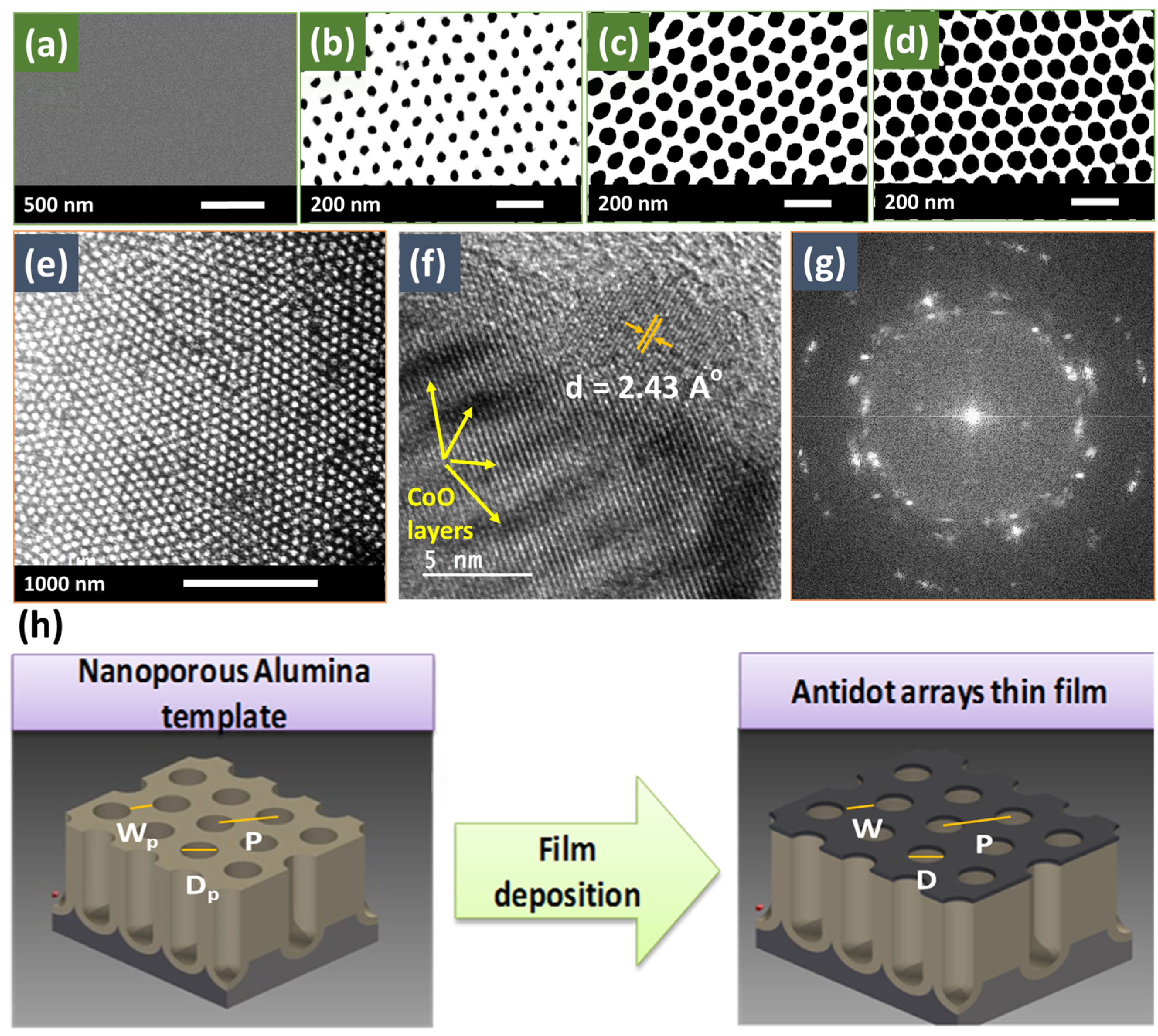
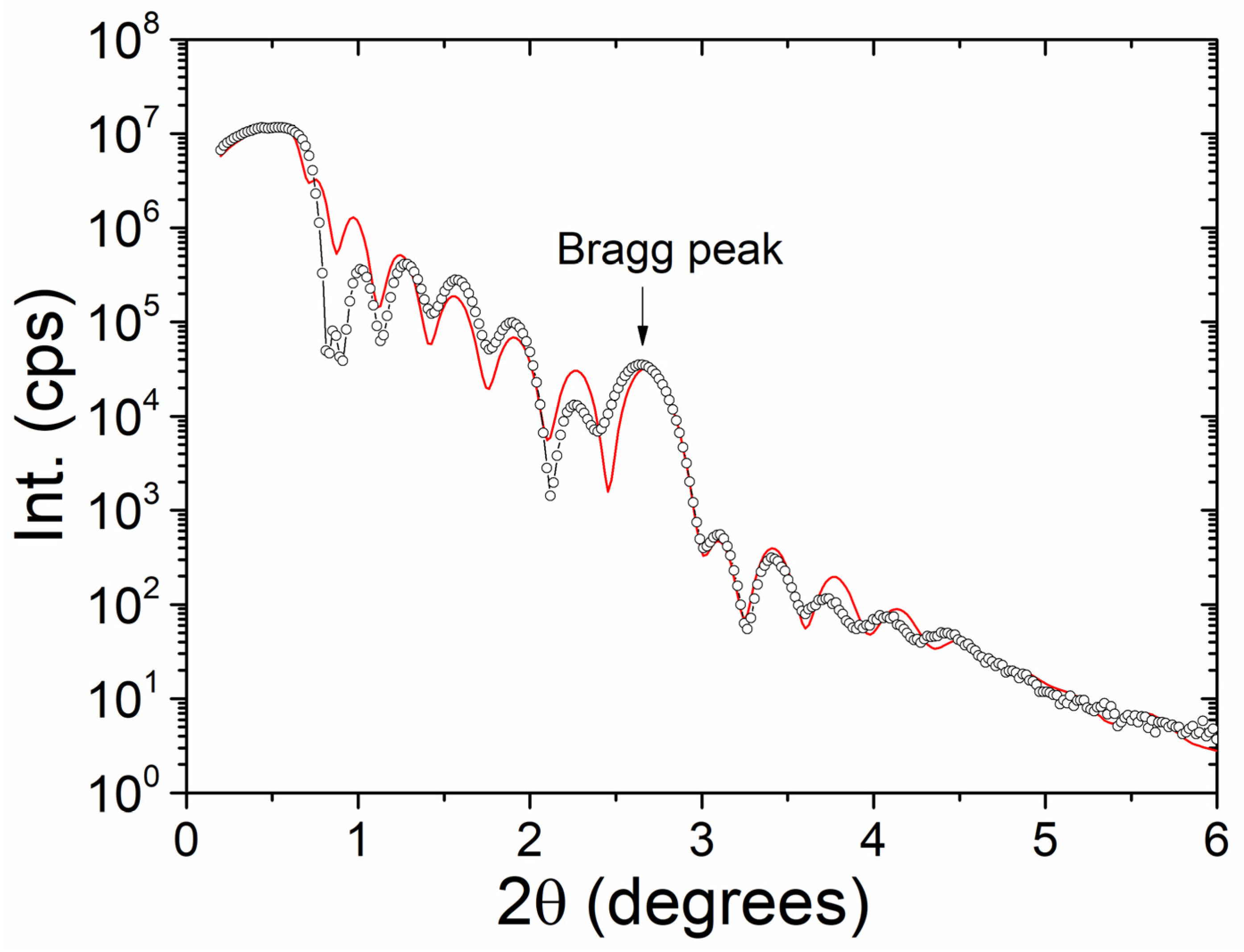

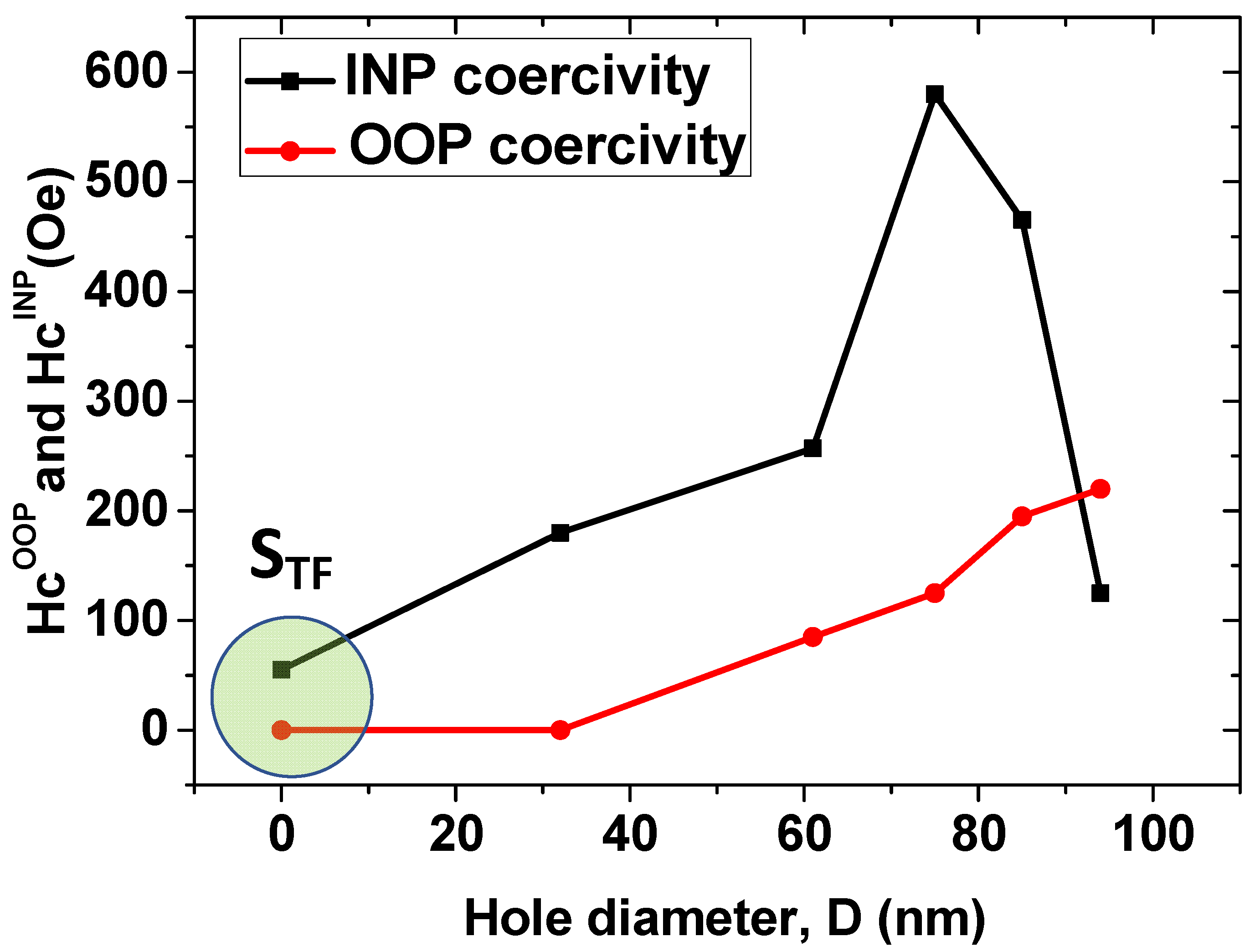
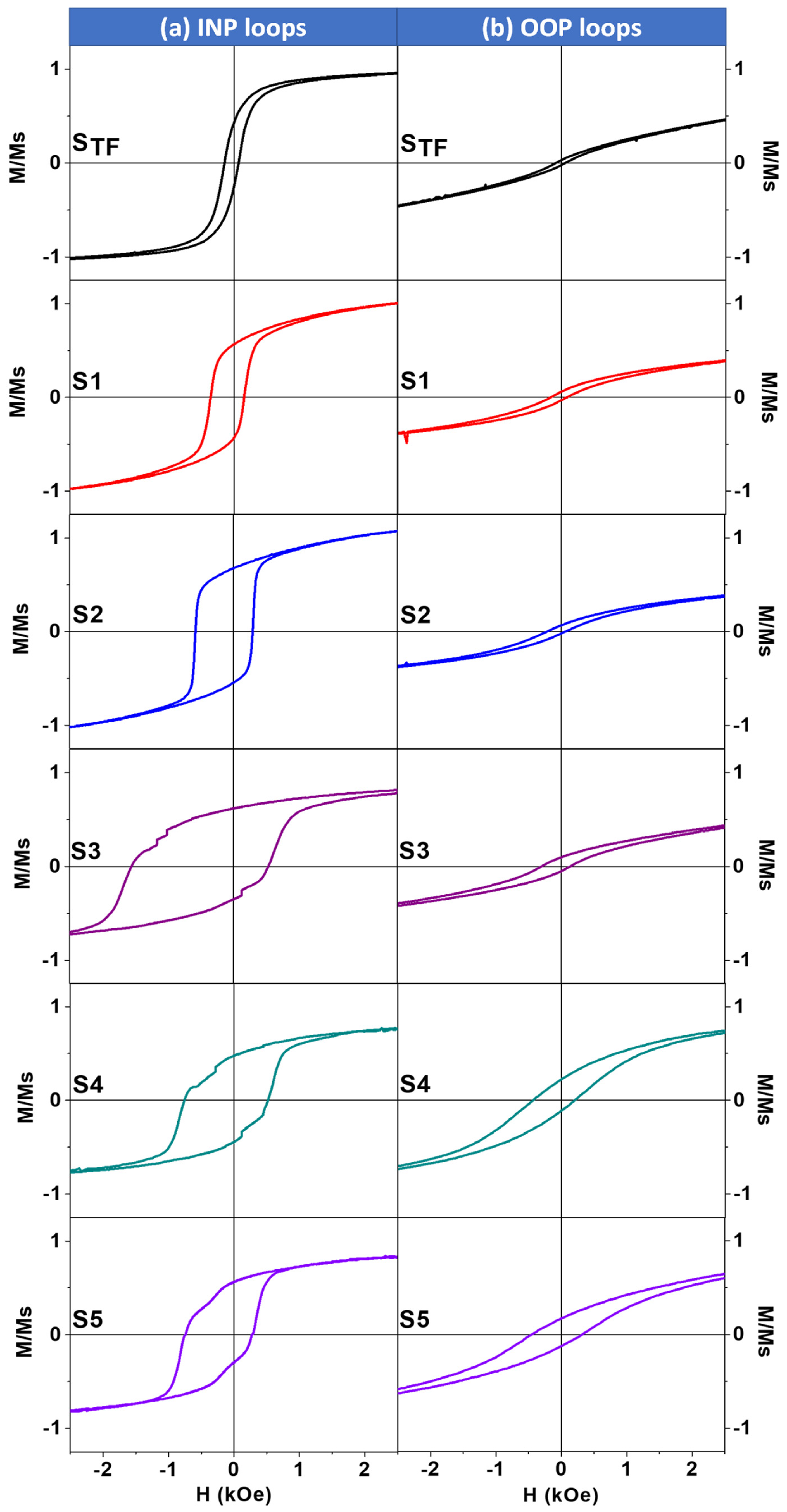
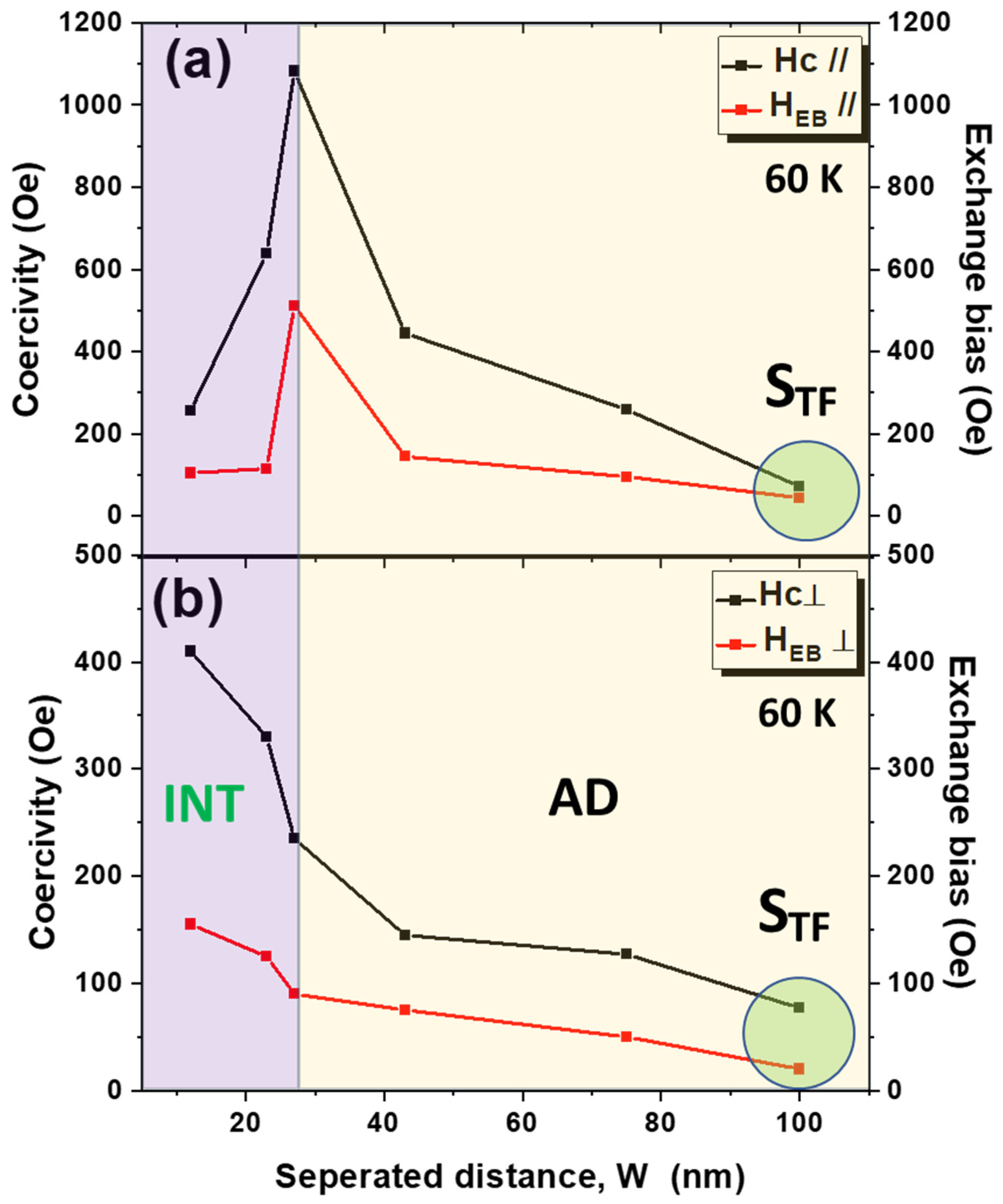
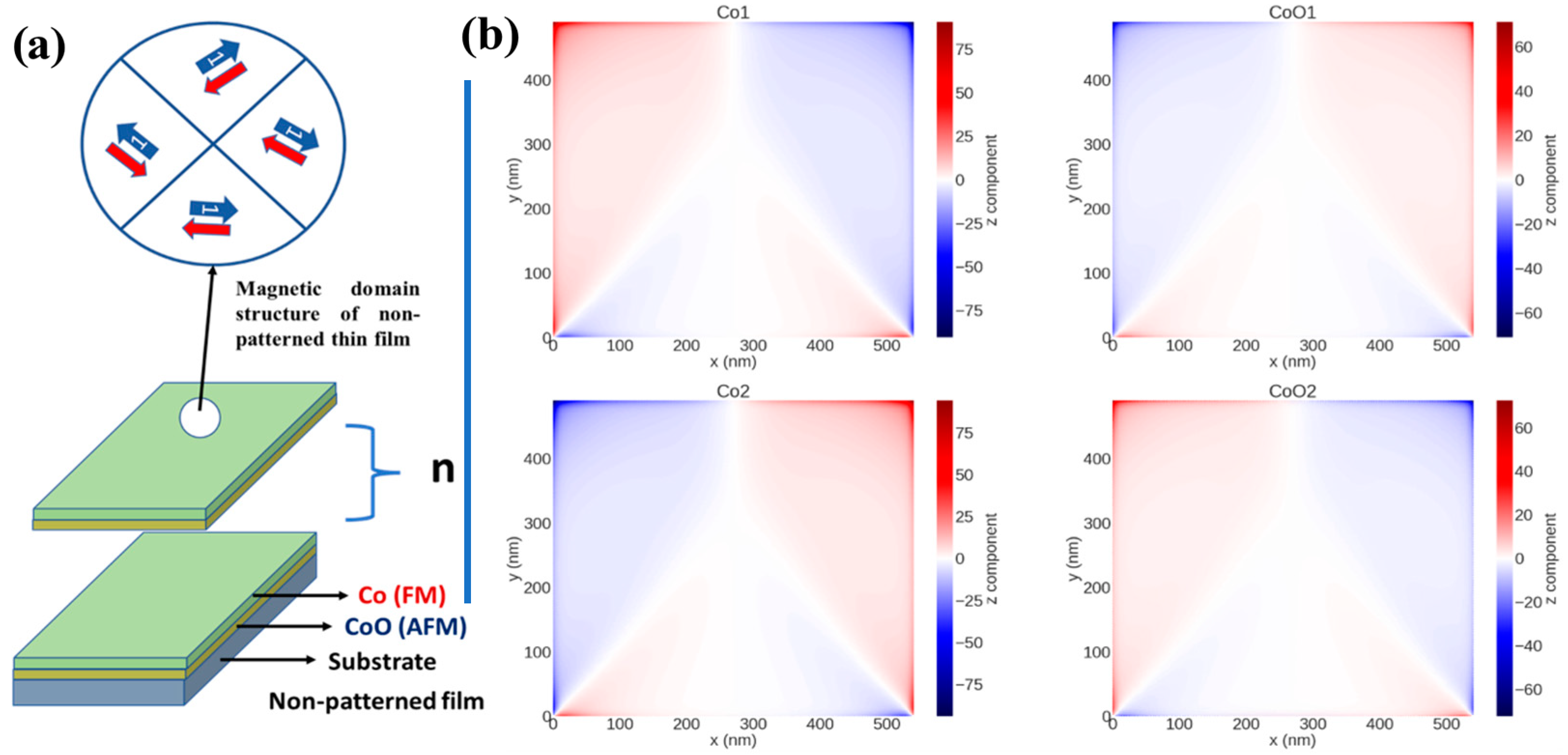

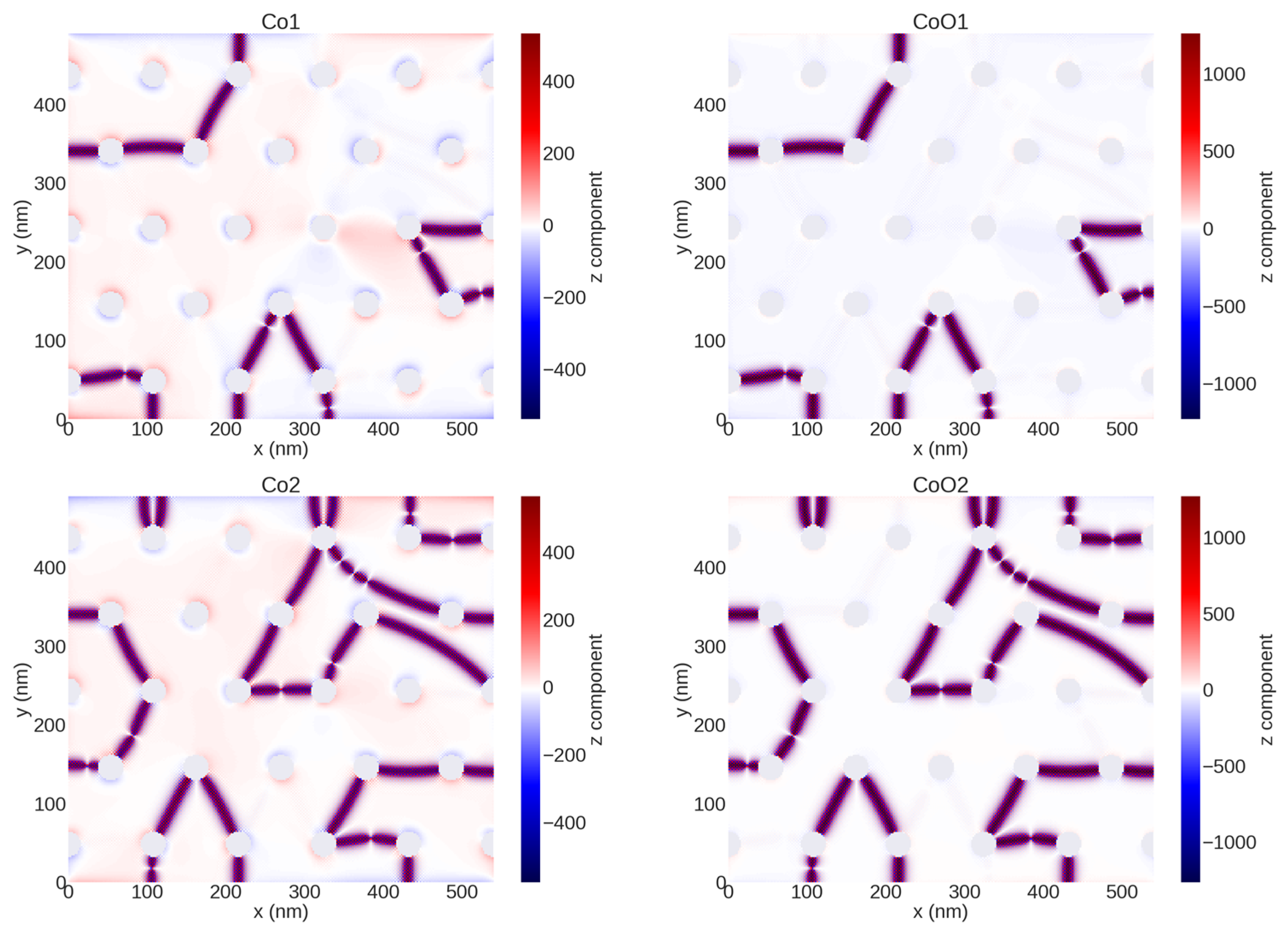
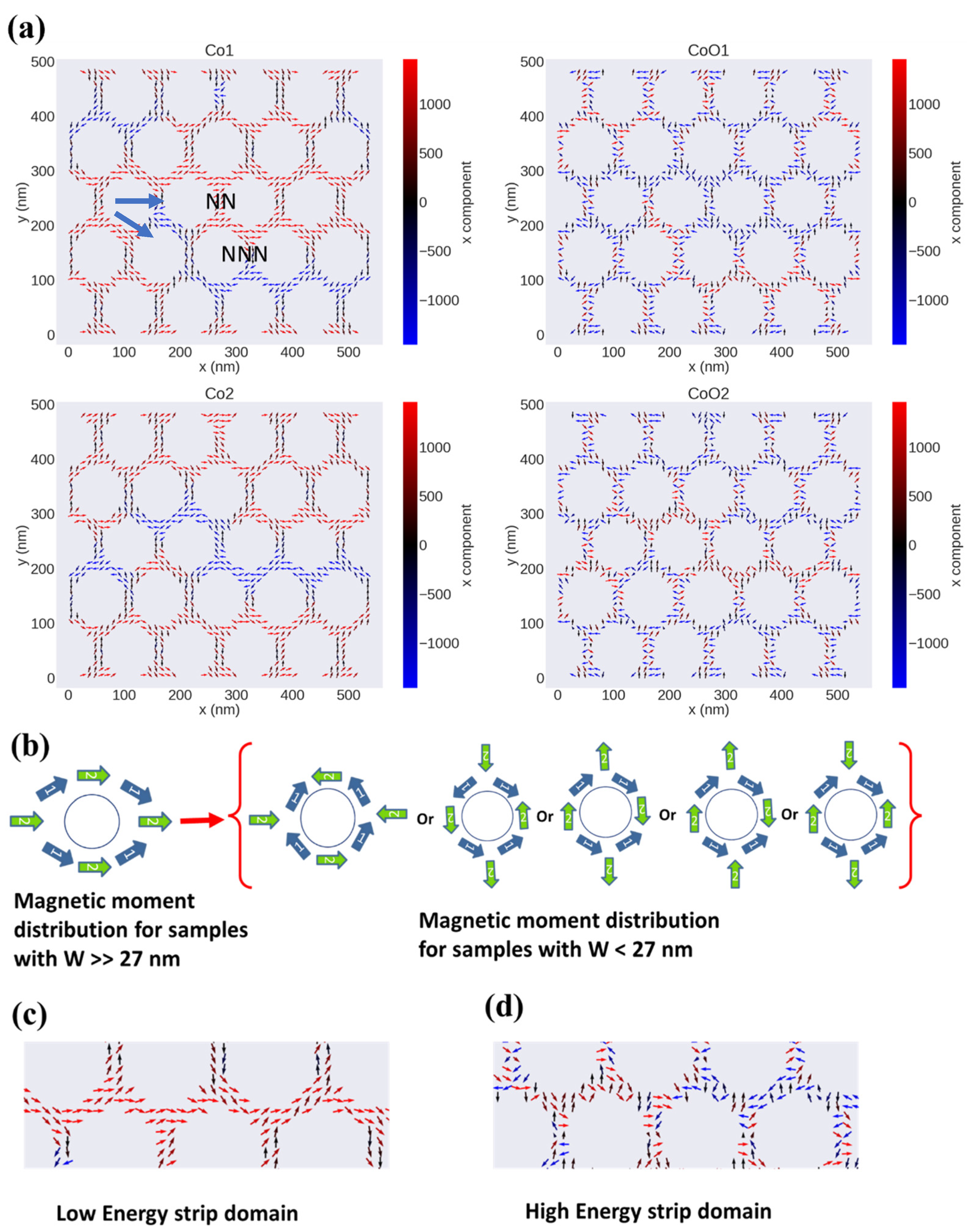
| Sample | Time Etching (min) | Dp (nm) | Wp (nm) | D (nm) | W (nm) | C (%) |
|---|---|---|---|---|---|---|
| STF | - | - | - | 0 | - | 100 |
| S1 | 25 | 34 ± 3 | 73 ± 3 | 32 ± 1 | 75 ± 2 | 92 |
| S2 | 34 | 64 ± 3 | 40 ± 3 | 61 ± 3 | 43 ± 4 | 69 |
| S3 | 48 | 78 ± 2 | 24 ± 3 | 75 ± 3 | 27 ± 3 | 51 |
| S4 | 65 | 87 ± 4 | 23 ± 3 | 85 ± 3 | 23 ± 2 | 44 |
| S5 | 75 | 96 ± 3 | 11 ± 3 | 94 ± 3 | 12 ± 2 | 29 |
Publisher’s Note: MDPI stays neutral with regard to jurisdictional claims in published maps and institutional affiliations. |
© 2022 by the authors. Licensee MDPI, Basel, Switzerland. This article is an open access article distributed under the terms and conditions of the Creative Commons Attribution (CC BY) license (https://creativecommons.org/licenses/by/4.0/).
Share and Cite
Salaheldeen, M.; Nafady, A.; Abu-Dief, A.M.; Díaz Crespo, R.; Fernández-García, M.P.; Andrés, J.P.; López Antón, R.; Blanco, J.A.; Álvarez-Alonso, P. Enhancement of Exchange Bias and Perpendicular Magnetic Anisotropy in CoO/Co Multilayer Thin Films by Tuning the Alumina Template Nanohole Size. Nanomaterials 2022, 12, 2544. https://doi.org/10.3390/nano12152544
Salaheldeen M, Nafady A, Abu-Dief AM, Díaz Crespo R, Fernández-García MP, Andrés JP, López Antón R, Blanco JA, Álvarez-Alonso P. Enhancement of Exchange Bias and Perpendicular Magnetic Anisotropy in CoO/Co Multilayer Thin Films by Tuning the Alumina Template Nanohole Size. Nanomaterials. 2022; 12(15):2544. https://doi.org/10.3390/nano12152544
Chicago/Turabian StyleSalaheldeen, Mohamed, Ayman Nafady, Ahmed M. Abu-Dief, Rosario Díaz Crespo, María Paz Fernández-García, Juan Pedro Andrés, Ricardo López Antón, Jesús A. Blanco, and Pablo Álvarez-Alonso. 2022. "Enhancement of Exchange Bias and Perpendicular Magnetic Anisotropy in CoO/Co Multilayer Thin Films by Tuning the Alumina Template Nanohole Size" Nanomaterials 12, no. 15: 2544. https://doi.org/10.3390/nano12152544
APA StyleSalaheldeen, M., Nafady, A., Abu-Dief, A. M., Díaz Crespo, R., Fernández-García, M. P., Andrés, J. P., López Antón, R., Blanco, J. A., & Álvarez-Alonso, P. (2022). Enhancement of Exchange Bias and Perpendicular Magnetic Anisotropy in CoO/Co Multilayer Thin Films by Tuning the Alumina Template Nanohole Size. Nanomaterials, 12(15), 2544. https://doi.org/10.3390/nano12152544












